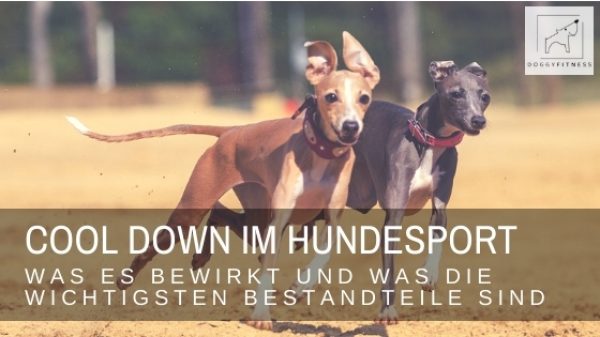Cool down in dog
Cool Down is completely overrated? That’s what we should be talking about. Because what actually happens after the sport, just back home? No way! Because the dog’s body is in performance mode even longer than you think.
First come down is on the plan!
A casual cool down or cool down should conclude any training session or competition. The goal is to bring the dog’s body back down to normal body temperature after exercise. This facilitates the regeneration of the body. In addition, injuries are reduced and good training results are achieved in the longer term.
What does power mode mean?
During sports, the cardiovascular system is stimulated to peak performance. The metabolism is accelerated. Pulse and breathing rate also go up. The muscle tension of the dog increases. Your dog is tense and highly concentrated.
What is a cool down supposed to do?
The Cool Down is a slow cooling down of the body according to a special rhythm. After sports, substances such as lactate must be removed. The metabolism, cardiovascular system, pulse and respiratory rate must also return to normal. In short, your dog needs to cool down and power down. That’s why it’s important to take time for the post-stress phase: the cool down.
What does that look like now?
For us humans it is the “running out” after the sport unit, horses are “dry ridden”. Your dog should also cool down slowly after intense exercise. For this he should e.g. loose run out. During relaxed walking or trotting, the used and oxygen-depleted blood is transported from the muscles to the heart. In this way, waste products are removed from the muscles. To do this, you avoid lesions on the Z-disks of the skeletal muscles, also known as muscle soreness. The muscle tension decreases again and your dog also calms down psychologically and reduces stress.
A cool-down can be easily achieved by taking a short walk and should be an integral part of any exercise session for your dog’s sake!
Additionally, light stretching exercises will help your dog loosen muscles after exercise. For instructions on stretching exercises, check out my blog post WARM UP – this is how it’s done!
In addition loosens a
MASSAGE
loosens the muscles and helps your dog to get back into rest mode. A positive side effect of the massage: you get a feeling for the muscles and notice early on if your dog may have tension, pain or a slight injury.
How long should you take for the Cool Down?
You can plan about 10-15 minutes for cooling.
How to tell if your dog’s levels are back in the normal range
Your dog’s breathing is a good way to judge whether pulse rate and circulatory values are back to normal. If breathing is within the normal range, you can assume that the other values are also within the normal range. After 20 minutes at the latest, the dog should have the same breathing and pulse rate as before the exercise. Does your dog take longer to normalize his breathing, pulse and cardiovascular system? Then he may have overexerted himself. You should make your next exercise session shorter or less intense. An important point: the better trained your dog is, the faster it will return to its resting levels.
The positive effect of the Cool Down on your training
Recovering after training is very important for the training process. The Cool Down will cause your dog to recover faster. This shortens the body’s regeneration phase and minimizes overuse damage.
Do you have questions about the post or a topic request? Then feel free to write me a comment or a message!
Dieser Beitrag ist auch verfügbar auf:
Français (French)
Deutsch (German)
Español (Spanish)















